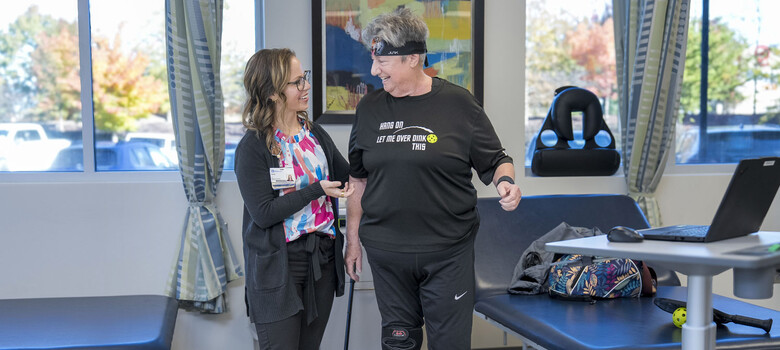 From the DukeHealth.org archives. Content may be out of date.
From the DukeHealth.org archives. Content may be out of date.
Pain Free and Active After Joint Replacement

Hip and knee replacements allow people to be pain free, often with no activity restrictions.
It sounds a little like an old joke:
“Doctor, will I be able to kite surf with my new hip?”
“I don’t know. Can you kite surf now?”
Bob Huizing, 48, of Buxton, North Carolina, can—and does—kite surf. He also goes snow boarding and mountain biking. He also had his hip replaced in 2008. Having an artificial hip doesn’t stop him from doing any of the sports he loves, he says. He just does them now without pain. “I tell people my aftermarket hip doesn’t bother me or slow me down at all,” he says. “It was the original one that did.”
Gwen Palmer, 59, knows that feeling well. The garden designer from Durham, North Carolina, also has an active lifestyle and a job that demands she be up and around. When her hip pain started slowing her down, she says she felt demoralized. “The pain was wearing me down, and I was functioning at a much slower pace,” she says. “After surgery, it got better quickly. A year later, I was better than 100%.”
Both Huizing and Palmer had total hip replacement by Duke orthopaedic surgeon David Attarian, MD. “Hip replacements allow people to be pain-free 99% of the time,” Dr. Attarian says. Afterward, patients really don’t have any activity restrictions. “They can do whatever they want, although we do discourage high-performance, dangerous activities,” he adds, “only because they could wear out their new hip prematurely.”
Thanks to advances in technology, today’s hip replacements last 20 to 30 years. “A lot has changed since this procedure was first available in the 1970s,” he says. “Initially, complication rates were high, and because of the material the hips were made of, they lasted 10 years if you were lucky.” Today, people of all ages are choosing joint replacement and having good success. “My oldest joint replacement patient was 96 years old,” Dr. Attarian says. “We don’t make decisions based on age, but on the physical condition of the patient and their plans for their life. We’re quality-of-life surgeons. Joint replacement doesn’t save lives, but it does make them better.”
That applies to new knees, too. Charles Martin, MD, of Jacksonville, North Carolina, has climbed to the top of Mount Kilimanjaro twice and to the base of Mount Everest once—all after the age of 72, and all after having a knee replaced. “I don’t want to be in Ripley’s Believe It or Not!, but I would like to climb Kilimanjaro again at age 80,” he says.
Martin says he has nothing but praise for Dr. Attarian. “He is very matter-of-fact and tells you what you can expect, no ice cream and cake,” he says. “I like that kind of physician.”
Is Joint Replacement For You?
People who have unmanageable pain might be candidates for total joint replacement. This pain may be caused by the following conditions:
Knee:
- End-stage arthritis of the knee
- Degenerative arthritis after a traumatic injury
- Rheumatoid arthritis or inflammatory arthritis
Hip:
- Osteoarthritis or rheumatoid arthritis
- Hip bone necrosis
- Hip fracture
The Duke Orthopaedics hip and knee replacement team, including Drs. David Attarian, Mike Bolognesi, Sam Wellman, Steve Olson, Rhett Hallows, and Scott Kelley, provide services at all three Duke hospitals: Duke University Hospital, Durham Regional Hospital, and Duke Raleigh Hospital.



